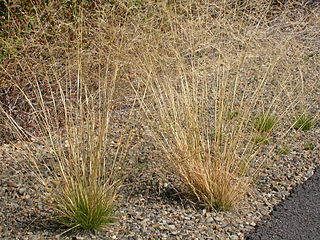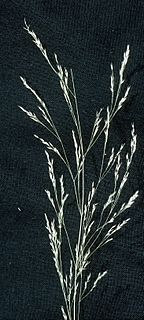
Agrostis is a large and very nearly cosmopolitan genus of plants in the grass family, found in nearly all the countries in the world. It has been bred as a GMO creeping bent grass.

Agrostis stolonifera is a perennial grass species in the family Poaceae.

Poa annua, or annual meadow grass, is a widespread low-growing turfgrass in temperate climates. Notwithstanding the reference to annual plant in its name, perennial bio-types do exist. This grass may have originated as a hybrid between Poa supina and Poa infirma.
Davidiella tassiana is a fungal plant pathogen infecting several hosts, including Iris barnumiae subsp. demawendica in Iran.
Agrostis mannii is a species of grass in the family Poaceae. It is found in Cameroon and Equatorial Guinea. Its natural habitat is subtropical or tropical dry lowland grassland.
Agrostis media is a species of grass in the family Poaceae. It is found only in Tristan da Cunha. Its natural habitats are subantarctic shrubland, subantarctic grassland, rocky areas, and rocky shores.
Agrostis trachychlaena is a species of grass in the family Poaceae. It is endemic to Inaccessible and Nightingale Islands, Tristan da Cunha. Its natural habitat is subantarctic grassland.

The Gough finch or Gough bunting, is a critically endangered species of songbird.

Anguina is a genus of plant pathogenic nematodes.

Agrostis capillaris, the common bent, colonial bent, or browntop, is a rhizomatous and stoloniferous perennial in the grass family (Poaceae). It is native to Eurasia and has been widely introduced in many parts of the world. Colonial bent grows in moist grasslands and open meadows, and can also be found in agricultural areas, roadsides, and invading disturbed areas.

Agrostis exarata is a species of grass known by the common names spike bentgrass, spike bent, Pacific bentgrass, and spike redtop. It is native to western North America from Texas to the Aleutian Islands.

Agrostis gigantea, known by its common names black bent and redtop, is a perennial grass of the Agrostis genus.

Lachnagrostis filiformis is a species of grass known by the common names Pacific bent grass, New Zealand wind grass, fairy grass, or blown-grass. It is native to Australia, New Zealand, and other Pacific Islands including New Guinea and Easter Island. While it is found in a wide variety of habitats, it seems particularly invasive in areas with damp soils, such as areas near bodies of water. It has been introduced to southern Africa, the United Kingdom, Taiwan, the southern United States and Mexico.

Agrostis scabra is a common species of grass known by the common names hair grass, rough bent, rough bent grass, winter bent grass, and ticklegrass. A tumbleweed, it is a bunchgrass native to Asia and much of North America, and widely known elsewhere as an introduced species.

Sporobolus virginicus, known by numerous common names including seashore dropseed, marine couch, sand couch, salt couch grass, saltwater couch, coastal rat-tail grass, and nioaka, is a species of grass with a wide distribution.
Cornucopiae is a genus of Mediterranean and Middle Eastern plants in the grass family. Common name is hooded grass.

Agrostis perennans, the upland bentgrass, upland bent, or autumn bent, is a species of flowering plant in the grass family, Poaceae.

Agrostis canina, the velvety bentgrass, brown bent or velvet bent, is a species of grass in the family Poaceae.

Agrostis castellana, the highland bent, dryland bent or dryland browntop, is a species of cool-season grass in the family Poaceae. It is native to Macaronesia and the Mediterranean, has been widely introduced elsewhere, and is considered an invasive species in some locales. It is a hyperaccumulator of zinc and lead.














